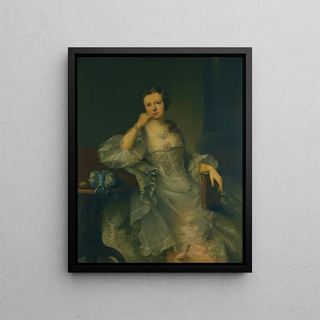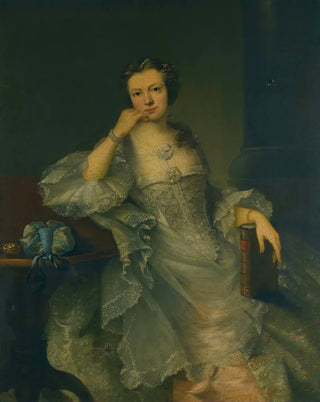Art print | Portrait of Miss Bullock - Sir Joshua Reynolds


View from behind

Frame (optional)
The "Portrait of Miss Bullock" by Sir Joshua Reynolds is an iconic artwork that embodies the elegance and refinement of the 18th century. This painting, created by one of the greatest portraitists of his time, transports us into a universe where art and beauty intertwine strikingly. Through this piece, Reynolds does not merely capture the appearance of his subject; he succeeds in evoking an atmosphere, a personality, and even a story. The delicacy of Miss Bullock's features, combined with the artist's technical mastery, makes this portrait a must-have for anyone interested in art history and the depiction of women in painting.
Style and uniqueness of the work
What immediately strikes in the "Portrait of Miss Bullock" is how Reynolds plays with light and shadow to bring his subject to life. The chosen colors, both soft and luminous, create a subtle contrast that highlights Miss Bullock's beauty. The choice of clothing, richly draped, not only reflects the social status of the young woman but also demonstrates the artist's virtuosity in rendering textures. Each brushstroke seems charged with emotion, and Miss Bullock's gaze, both serene and penetrating, invites the viewer to ponder her thoughts and aspirations. The composition, balanced and harmonious, reveals a keen sense of proportion, an essential characteristic of Reynolds' style, who knows how to marry realism with a certain idealization.
The artist and his influence
Sir Joshua Reynolds, a major figure in English painting, managed to leave his mark on his era through his innovative approach to portraiture. As the first president of the Royal Academy, he played a decisive role in establishing the artistic standards of his time. His influence extends well beyond his country's borders, inspiring many artists across Europe. Reynolds was also a pioneer in the use of light and color, prefiguring artistic movements that would emerge later, such as Impressionism. His talent for capturing not only physical appearance but also the very essence of his models redefined expectations related to individual representation in

Matte finish

View from behind

Frame (optional)
The "Portrait of Miss Bullock" by Sir Joshua Reynolds is an iconic artwork that embodies the elegance and refinement of the 18th century. This painting, created by one of the greatest portraitists of his time, transports us into a universe where art and beauty intertwine strikingly. Through this piece, Reynolds does not merely capture the appearance of his subject; he succeeds in evoking an atmosphere, a personality, and even a story. The delicacy of Miss Bullock's features, combined with the artist's technical mastery, makes this portrait a must-have for anyone interested in art history and the depiction of women in painting.
Style and uniqueness of the work
What immediately strikes in the "Portrait of Miss Bullock" is how Reynolds plays with light and shadow to bring his subject to life. The chosen colors, both soft and luminous, create a subtle contrast that highlights Miss Bullock's beauty. The choice of clothing, richly draped, not only reflects the social status of the young woman but also demonstrates the artist's virtuosity in rendering textures. Each brushstroke seems charged with emotion, and Miss Bullock's gaze, both serene and penetrating, invites the viewer to ponder her thoughts and aspirations. The composition, balanced and harmonious, reveals a keen sense of proportion, an essential characteristic of Reynolds' style, who knows how to marry realism with a certain idealization.
The artist and his influence
Sir Joshua Reynolds, a major figure in English painting, managed to leave his mark on his era through his innovative approach to portraiture. As the first president of the Royal Academy, he played a decisive role in establishing the artistic standards of his time. His influence extends well beyond his country's borders, inspiring many artists across Europe. Reynolds was also a pioneer in the use of light and color, prefiguring artistic movements that would emerge later, such as Impressionism. His talent for capturing not only physical appearance but also the very essence of his models redefined expectations related to individual representation in






